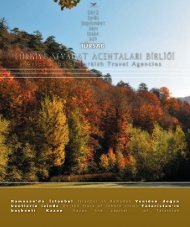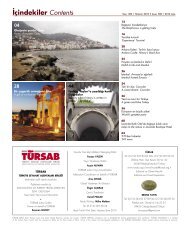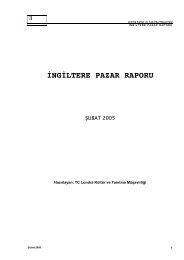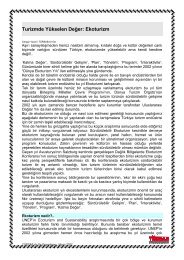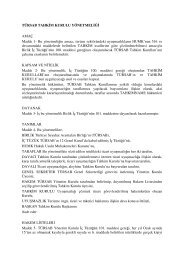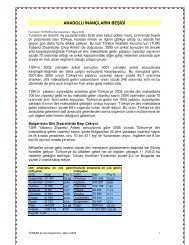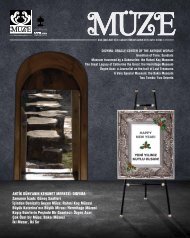Yedigöller Milli Parkı - Türkiye Seyahat Acentaları Birliği
Yedigöller Milli Parkı - Türkiye Seyahat Acentaları Birliği
Yedigöller Milli Parkı - Türkiye Seyahat Acentaları Birliği
Create successful ePaper yourself
Turn your PDF publications into a flip-book with our unique Google optimized e-Paper software.
Rasim Konyar<br />
Onların ortak özelliği, çoğunun ahşap olması, 7-8<br />
yüzyıldan bu yana yaşayabilmesi ve bezemeleri!<br />
Oysa, İslamın da etkisiyle bu dünyanın “geçici”<br />
olduğuna inananlar, ahşabı, ancak bir iki kuşak<br />
daha kullanılacak “ev” için seçip anıtsal ve kamu<br />
yapılarında “taş” kullanırdı. Su yolları, çeşmeler,<br />
köprüler ve kuşaktan kuşağa hizmet vermesi için<br />
külliyeler ve göğe uzanan minareleriyle camiler<br />
gibi. Ama Anadolu’da ahşap da en az onbin<br />
yıldır kullanılan bir malzeme. İşte Selçuklularla<br />
gelen, ağaç direkli ve ahşap tavanla örtülü<br />
camiler! Hele Karadeniz gibi ormanı bol yerlerde<br />
kamu yapıları da ahşaptan yapılmış. Öyle ki bu<br />
sayıda paylaştığımız örneklerde olduğu gibi çivi<br />
ve benzeri gibi başka metal de kullanılmamış.<br />
Ama buna karşılık alabildiğine yaşam sevinci ile<br />
donatılmış, bezenmişler. Hem de yaşamın en<br />
güzel, en estetik simgesi ile: “Çiçek”!<br />
Anadolu’da resim ve mimari ilişkisi<br />
Anadolu’da mimari ve resim ilişkisinin bilinen en<br />
eski örnekleri Uygur prensleri, rahipler, kadınlar<br />
gibi insan figürleri ve yaşanmış olayların yanı<br />
sıra, sembolik çiçek ve hayvan tasvirlerinin önemli<br />
yer tuttuğu, Uygurlara ait duvar resimleri. 18.<br />
yy.da Osmanlı Batı’ya açılırken, Avrupa’da “fresk”<br />
tekniğiyle yapılanlar, bizde “kalem işi” tekniğiyle<br />
bir tür duvar resmine dönüşüyor (*). Gerçek veya<br />
hayali bir manzara, belli bir yapı, cami, konak<br />
tasvirleri, gemiler ve sembolik motifler gibi.<br />
Saraydan Anadolu’ya<br />
18. ve 19. yy.da bütün alanlarda ithal edilen Batılı<br />
biçimler, örneğin Lale Devri’nde yurtdışından<br />
gelen mobilya ve saatler üzerindeki manzaralar,<br />
kase ve vazolardaki çiçek resimleri, Osmanlı<br />
resimsel bezemelerinde de görülüyor. En canlı<br />
örnek, Topkapı Sarayı. Tavan eteklerini dolaşan<br />
manzara şeritlerinde; sularla bölünmüş kara<br />
parçaları üzerinde yükselen yapılar, ağaçlar,<br />
denizde yüzen insansız kayıklar, yelkenliler ve<br />
adalar, Boğaziçi, ağaçlar... Duvar panolarında<br />
da Boğaziçi kasırları, kadırgalar ve çeşmeler...<br />
Osmanlı’da “yan” diye anılan ileri gelenler,<br />
İstanbul’daki akımların taşraya taşınmasında<br />
önemli rol oynamış ve 18. yy.da yeni dekor<br />
ve süsleme akımının zengin örneklerini kendi<br />
konaklarına yansıtırken, camileri de unutmamışlar.<br />
İşte bu yüzden duvar resimlerinin de en zengin<br />
örnekleri, âyanlık kurumunun daha güçlü olduğu<br />
Batı Anadolu’da daha çok görülüyor!<br />
(*) “19. yüzyıl Osmanlı Camilerinde Kalem İşi<br />
Tezyinatı”, Oktay Hatipoğlu, 2007, Erzurum<br />
Floral Mosques of Anatolia<br />
The common characteristics of mosques are their ornaments,<br />
most of which are wooden. Many have survived since the 7 th and<br />
8th centuries. The influence of Islam would lead those who believe<br />
that this world is “temporary” to choose wood for “houses” which<br />
are to be used for at most one or two generations and to use<br />
“stone” instead for monuments and public structures, such as<br />
water ways, fountains, bridges and Islamic social centers that<br />
must last for many generations and mosques that rise high above<br />
the sky with their towering minarets.<br />
However, wood has also been used for at least 10.000 years in<br />
Anatolia. These are the mosques with roots back to Seljuk that<br />
use wooden poles and wooden ceilings. Even public buildings<br />
are made of wood in regions full of forests such as the Black Sea<br />
region. As can be seen in the examples given in this edition, no<br />
metals, including nails, etc., are used. On the contrary, they are<br />
ornamented and adorned with the joy of life all out. With the most<br />
beautiful, most aesthetical symbol of life: flowers!<br />
The relation between painting and architecture in<br />
Anatolia<br />
The oldest examples of the relation between painting and<br />
architecture in Anatolia are wall paintings of Uighurs which<br />
are dominated by historical events and human figures such as<br />
Uighur princes, monks, women, and also by symbolic flowers and<br />
depictions of animals. While the Ottomans expanded to the West<br />
in the 18 th century, the art which was produced using the “fresco”<br />
technique in Europe is converted to some type of wall paintings<br />
through a “hand-carving” technique (a technique used to bind the<br />
wood together without nail). Examples include real or imaginary<br />
views, certain structures, mosques, mansion images, ships, and<br />
symbolic themes.<br />
From the Palace to Anatolia<br />
Western styles that are imported to all sorts of areas in the<br />
18 th and 19 th centuries (for instance landscapes on furniture<br />
and watches brought from abroad in the Tulip period, and<br />
flower patterns in bowls and vases) can be seen in the pictorial<br />
ornaments of the Ottoman. The most vivid example is Topkapı<br />
Palace! Structures rising above lands divided by water on the<br />
landscape, belts that surround Ceiling skirts, trees, unmanned<br />
boats, sailboats floating on the sea, islands, Bosporus and trees…<br />
Bosporus pavilions, galleys and fountains on wall panels…<br />
Ottoman dignitaries, the so-called “sides” played a crucial role<br />
in transferring art movements in Istanbul to villages. While they<br />
reflected the rich examples of new décor and ornamentation of<br />
the 18 th century in their palaces, they did not neglect mosques.<br />
Thus, the richest examples of wall paintings can be seen more<br />
frequently in Western Anatolia where Ayan Institution (a kind of<br />
parliament consisting of wise men) are more in charge. (*) “19.<br />
yüzyıl Osmanlı Camilerinde Kalem İşi Tezyinatı”, Oktay Hatipoğlu,<br />
2007, Erzurum<br />
TÜRSAB DERGİ | HAZİRAN 2013 21



